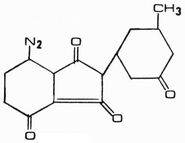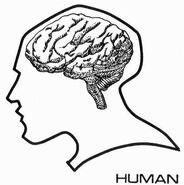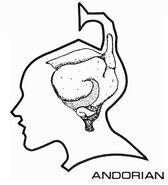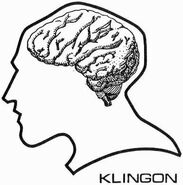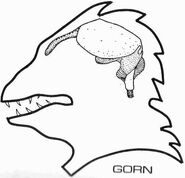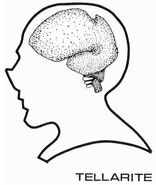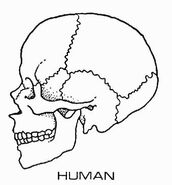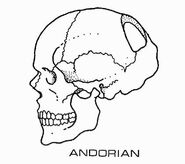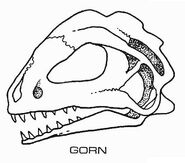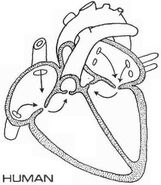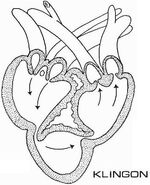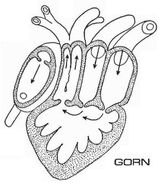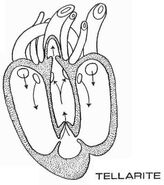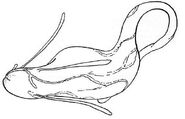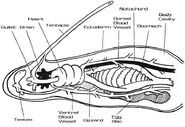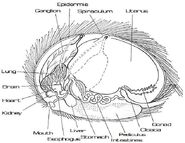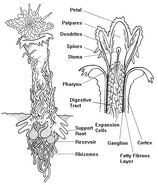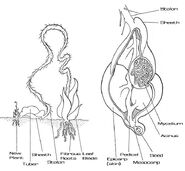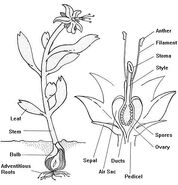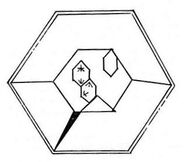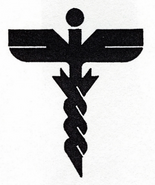The Star Fleet Medical Reference Manual is a reference book showing various anatomies of species (both humanoid and non-humanoid) from the 23rd century, as well as various medical techniques.
Summary[]
A Publication of the Star Fleet Surgeon General.
WARNING: The Surgeon General's medical reference manual is intended as a basic source of medical information for starship crewmembers, and is not an alternative to treatment by a physician. First aid procedures should be used with caution, and only by trained personnel.
Hippocratic Oath[]
The first thing any physician should know is the Hippocratic Oath, created by Hippocrates (460-370 B.C.) cited as the "Father of Terran Medicine."
Introduction[]
An essay on the "Historical Trends in Medicine" by John Gill, Ph.D. explains about how surgeons have been on ships created by humans since they first ships were built. And that how those surgeons have written books on "naval medical practices," such as the first such one on Earth: "The Surgeon's Mate" by John Woodall in 1617 or "The Starship's Medical Chest and First Aid in Space," published in 2105.
Historical[]
A timeline of important medical discoveries, failures, and plagues that have affected various important planets, starting with the Great Plague ("skag maug") on Vulcan that caused thousands of deaths, and continuing through to the present "Federation Era." The timeline ends c. 2260.
- Various dates and pieces of historic information are, of course, later contradicted by both reality and future Star Trek series. One example is that the founding date of the United Federation of Planets is listed as 2125, instead of 2161. No effort has been made as yet to reconcile the dates of this example.
- See also: T'Laan.
Medical[]
A "Periodic table of the Elements (Fifth Interstellar Geophysical conference standard)" lists the elements, 1 (Hydrogen) to 129 (Tricobalt), and 139 (Kironide) and 140 (Corbomite).
- Interestingly, James Kirk seemed to imply that corbomite was a fictional material that he had made up, but it is listed as having been discovered in 2262 at Starbase 27.
Followed by a list of all the elements, their symbol, atomic weight (by mass number of most stable isotope), atomic weight, place of discovery, and date of discovery. (If humans discovered it prior to first contact, that place and date is given.) All dates use the Earth calendar where not specially marked using the Post-Surak Vulcan calendar.
- Radiation
Drugs[]
Diseases[]
- This is prefaced by a passage from the Third Edition of "Pathology: Treating The Unknown" credited to McCoy.
Life Sciences[]
- Vulcan Physiology
Humanoid Anatomy[]
- Andorian
- Insectoid biped (Homo indi)
| Average weight: | 70 kilos (male) 45 kilos (female) |
| Blood pressure: | 160/110 (male) 180/120 (female) |
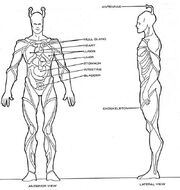
Andorian internal anatomy
Andorians are a blue-skinned humanoid species, average height: 2.3 meters (male) 1.8 meters (female). They have a life expectancy of 129 years for males and 134 years for females.
Their eyes are unusual in that they do not process the whole spectrum of light, and have to be used in unison with their antennae. Andorians vision is called "quadroscopic," and is limited to tones of gray. Their auditory receptors (in their antennae) are more advanced then many other humanoids, capable of distinguishing independent sounds from a crowd. Also, to better focus their senses, Andorians will lean their head down towards a person to whom they are listening, to better focus their monodirectional antennae.
- Here, the Andorians are depicted as not having "pinnae," or outer ears. This is based on the fact that that the antennae were presumed as the basic audio sensor, and that throughout their TOS appearances their thick white hair covered where humanoid ears--or the ears of the actors acting them out--would have been.) The first prominently displayed Andorian with ears was the Andorian Federation Councilor from Star Trek IV: The Voyage Home, produced 9 years later.
- Later contradictions include the fact that Andorians have non-moving antennae and the presence of only male/female genders. Clearly shown in Star Trek: Enterprise, it was mentioned that they could "point their antennae" at people in DS9: "The Sound of Her Voice." First alluded to by Data's line regarding four-partnered marriage in the TNG episode Data's Day, Andorians are a four-gendered species with all four required to combine in union for procreation.
- Gorn
- Reptiloid biped (Homo lacertae)
| Average weight: | 200 kilos (male) 100 kilos (female) |
| Blood pressure: | 80/50 (male) |
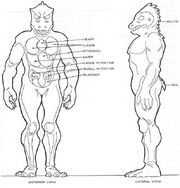
Gorn internal anatomy
The Gorns are a green reptilian humanoid species, average height: 2 meters (male) 1.4 meters (female). They have a life expectancy of 55 years for males and 21 years for females.
Being cold-blooded, they require ambient warmth and prefer to live in tropical climates. Their respiration system is less advanced than most, and provides just enough oxygen to the body to remain functioning. One internal source of temperature is when a female Gorn gives birth: Gorns lay eggs, which hatch while still inside the oviduct and appear to be live births. Their eyes are covered in thousands of facets, each with its own protective lid.
| Average weight: | 70 kilos (male) 60 kilos (female) |
| Blood pressure: | 120/80 |
Humans are a red-blooded "humanoid" species (originators of the name) with average heights of: 1.7 meters (male) 1.5 meters (female). They have a life expectancy of 115 years for males and 122 years for females.
Information on Human anatomy is abundant, and as such is excluded from this particular manual. Texts regarding humans is available at your local Star Fleet Supply Center for merely 5 credits. Or, for more information, you are advised to contact:
- Star Fleet Surgeon General
- Federation Institute of Medicine
- 1 Zefram Cochrane Plaza, New York City
- Earth - Sol System - United Federation of Planets
- According to the literature, within the next 300 years, the scientific nomenclature for a human will change from Homo sapiens to Homo sol, referencing the home star of the species. Of course, Spock's repeated usage of the term Homo sapiens in TOS dialogue contradicts this.
- Klingon
- Klingonoid biped (Homo sagittarii)
| Average weight: | 80 kilos (male) 50 kilos (female) |
| Blood pressure: | 130/80 |
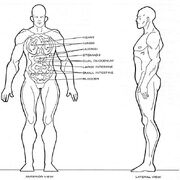
Klingon-augment internal anatomy
Klingons are a well known "humanoid" species famous for their use of bio-engineering by their government to selectively breed out the impure in their species, so only the best survive. They have an average heights of: 1.9 meters for males and 1.7 meters for females. They have a life expectancy of 82 years for males and 69 years for females.
Their single stomach has two "duodenum," which increase digestive flow efficiency to their small intestines. Special notice is given to their small intestine, and physicians should be careful: as their unique design is "stairway-like levels," which first twist downward, then upward again into the large intestine. The higher body temperature in Klingons are caused by their second liver.
- Although its publication predated the premiere of Star Trek: The Motion Picture, and thereby the first appearance of Klingon forehead ridges, the book still predicts that Klingons have undergone some form of genetic engineering as explained in the Star Trek: Enterprise episodes "Affliction" and "Divergence."
- However, the book fails to predict the numerous redundant systems (or "brak'lul") explained in TNG's "Ethics." They are, however, shown to have a redundant liver, more variety than most anatomies in the book.
- Tellarite
- Artiodactyloid biped (Homo cygni)
| Tellarite anatomy | |
| Average weight: | 80 kilos (male) 150 kilos (female) |
| Blood pressure: | 160/110 (male) 180/120 (female) |
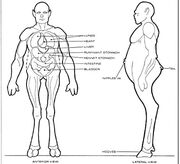
Tellarite internal anatomy
Tellarites are a vaguely pig-like humanoid species, representatives of which are known to share several characteristics with the non-sentient Earth life form. They have an average heights of 1.8 meters for males and 2.2 meters for females. They have a life expectancy of 87 years for males and 93 years for females.
Tellarite legs end in two-toed feet with hooves. Their femurs are notable for missing their third trochanters, and their fibulae are vestigial. Their digestive system is designed for plants, and as such they have two stomachs which utilize bacteria to break down the food before entering their single intestine. They often have multiple births, and their sense of smell and hearing is advanced for a humanoid, while their eyesight is sub par.
- The book seems to imply that Tellarites are herbivores, and that their stomachs cannot digest meat. But in Enterprise we learn that canines are a delicacy on Tellar Prime. Also, although no close up has been specifically focused on the legs or feet of Tellarites, the series do not seem to support the "hoofed, pig-like feet" theory used here.
- Vulcan
- Vulcanoid biped (Homo eridani)
Vulcans are a green-blooded humanoid species with average heights of 2.0 meters for males and 1.7 meters for females. They have a life expectancy of 250 years.
Only minor variations exist between the vulcanoid species, such as the Rigelians of Rigel V, and the Romulans. For more information on the Vulcans, refer to the "Vulcan Physiology" portion of this manual.
- Brain (Encephalic) Development
- Cranial (Skull) Development
- Heart (Cardiac) Development
- Cell structure
- Humanoid Psychology
Intelligent Aliens[]
- Carbon-Cycle Life Form - Excalbia (Excalbia hominidae)
- Horta - Janus VI (Janus hominidae)
- Medusan - Xi Hydrae V
- Orthinoid Alien - Pyris VII (Vita xenos)
- Tholian - Tholia
Parasites[]
- Denebian slime devil - Deneb IV (Denebia carnivora)
- Flying parasite - Large Magellanic Cloud? - "Blastoneuron"
- Regulan bloodworm - Regulus II (Regulani vermis)
- Tribble - Iota Geminorum IV (Polygreminus grex)
Plants[]
- 'Beauregard' (Weeper) - Zeta Reticuli A (Terrestrius manus)
- Borgia plant - M113
- Mako root plant - Neural
- Pod plant - Gamma Trianguli VI
- Spore plant - Omicron Ceti III
- Psionics
- This makes mention of the human aura, which Semyon Kirlian initially claimed his corona-discharge photography technique could detect. But unfortunately, it reads as though its author were megalophobic and cratophobic, hating both greatness and power respectively, and strikes some readers as an anti-power hate screed that they think McCoy might have written. This is evident in its treatment of Gary Mitchell, about whom his best friend, James Kirk--who had been forced to kill him in "Where No Man Has Gone Before"--is blatantly misquoted.
- Chiropractic
First Aid[]
- Artificial Ventilation
- Carry Techniques
- Three-man lift
- Chair carry
- Four-handed seat
- Two-handed seat
- Pulling the victim
- Lifting & supporting the victim
- Classification of Burns
- Cardiopulmonary Resuscitation (C.P.R.)
- Dislocation of the Superior Cortex
- Mouth-to-mouth Resuscitation
- Foreign Body Obstruction of the Airway
- Mugato Bite
- Opening the Mouth
- Vulcan Cardiac Arrest
Equipment[]
- Medical tricorder
- Medikit
- Medipouch
- Sickbay Diagnostic Scanner
- Spray Hypo
References[]
Materials, substances & energies[]
Elements[]
actinium • algobarium • aluminum • americum • antimony • argon • arsenic • astatine • barium • berkelium • beryllium • bismuth • boridium • boron • bromine • cadmium • calcium • californium • carbon • celebium • cerium • cesium • chlorine • chromium • cobalt • colladium • copper • corbomite • curium • diburnium • dikironium • dilithium • dysprosium • einsteinium • element 106 • element 107 • element 108 • element 109 • element 110 • erbium • europium • fermium • fluorine • francium • gadolinium • gallium • germanium • gold • hafnium • hahnium • helium • holmium • hydrogen • indium • indurite • iodine • iridium • irillium • iron • kironide • krypton • kurchatovium • lanthanum • lawrencium • lead • lithium • lutetium • magnesium • manganese • mercury • molybdenum • murinite • neodymium • neon • neptunium • nickel • niobium • nitrogen • nobelium • osmium • oxygen • palladium • pergium • phosphorus • platinum • plutonium • polonium • potassium • praseodymium • promethium • protactinium • radium • radon • rhenium • rhodium • rodinium • rubidium • rubindium • ruthenium • samarium • scandium • selenium • silicon • silver • sodium • strontium • sulfur • tantalum • technetium • tellurium • terbium • thallium • thorium • thulium • tin • titanium • topaline • tricobalt • tritanium • trititanium • trivium • tungsten • uranium • vanadium • xenon • ytterbium • yttrium • zienite • zinc • zirconium
Other[]
Chronology[]
- 1900
- The element radon discovered in Germany on Earth.
- 1901
- The element europium discovered in France on Earth.
Appendices[]
Background[]
- Star Trek: Deep Space Nine used several of the images from the "Intelligent Aliens" and "Parasites" chapter on an LCARS graphic in the back of the school room, making the internal physiology shown in the book at least partially canon. These included the Denebian slime devils, Regulan bloodworms, Tribbles, Excalbians, the Horta, Neural parasites and Korob's and Sylvia's species.
- This is not the first example of Star Trek using the non-canon (and sometimes, not even authorized) reference books in the television series: Some of the early Star Trek movies used images from the Star Fleet Technical Manual by Franz Joseph. Also, the RPG reference book "Among the Clans" was used by the writing staff of Star Trek: Enterprise when creating the ushaan, as well as making Andoria a frozen planet.
- Other publications have utilized images from the book as well (although by then they technically had been made canon by DS9.) Star Trek: The Magazine featured several animal species in an issue, and included the internal anatomy of the Tribble. The Starfleet Survival Guide features a diagram of the Denebian slime devil that first appeared in this book.
Images[]
External link[]
- Star Fleet Medical Reference Manual article at Memory Alpha, the wiki for canon Star Trek.


